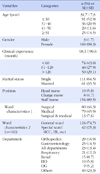Abstract
Purpose
This study was done to identify the effects of Type D personality on compassion fatigue, burnout, compassion satisfaction, and job stress in clinical nurses.
Methods
A descriptive cross-sectional design was used. Data were collected from a convenience sample of 172 clinical nurses working in two tertiary hospitals. The structured questionnaires included Type D personality scale, compassion fatigue, burnout, compassion satisfaction, and job stress scales.
Results
About 79.7% of participants were classified as Type D personality group. The Type D personality was not related to general characteristics of clinical nurses. The Type D personality group showed statistically significant higher compassion fatigue, burnout, and job stress and lower compassion satisfaction compared to the non-Type D personality group. In addition, compassion fatigue and burnout were positively correlated with job stress and compassion fatigue was positively correlated with burnout. However, compassion satisfaction was negatively correlated with burnout.
Conclusion
As the prevalence of Type D personality is high in clinical nurses, it is necessary to assess stress-related personality. In addition, management for the nurse with Type D personality is required to alleviate compassion fatigue, burnout, and job stress and to improve compassion satisfaction.
Figures and Tables
Table 2
Frequency of Type D Personality and Scores of Compassion Fatigue, Burnout, Compassion Satisfaction, and Job Stress (N=172)

References
1. Hamaideh SH, Ammouri A. Comparing Jordanian nurses' job stressors in stressful and non stressful clinical areas. Contemp Nurse. 2011; 37(2):173–187. http://dx.doi.org/10.5172/conu.2011.37.2.173.
2. Wu H, Chi TS, Chen L, Wang L, Jin YP. Occupational stress among hospital nurses: Cross-sectional survey. J Adv Nurs. 2010; 66(3):627–634. http://dx.doi.org/10.1111/j.1365-2648.2009.05203.x.
3. Han AK, Kim OS, Won JS. A study on job stress and coping method by the personality types of clinical nurses. J Korean Clin Nurs Res. 2007; 13(2):125–136.
4. Son YJ, You MA, Song EK. Influence of Type D personality on health-related quality of life among Korean patients with end-stage renal disease. Int J Nurs Pract. 2012; 18(3):260–267. http://dx.doi.org/10.1111/j.1440-172X.2012.02030.x.
5. Song EK, Son YJ. The analysis of type D personality research as a psychosocial risk factor in cardiovascular disease for elders with a chronic disease. J Korean Acad Nurs. 2008; 38(1):19–28.
6. Denollet J. Type D personality: A potential risk factor refined. J Psychosom Res. 2000; 49(4):255–266.
7. Healy CM, McKay MF. Nursing stress: The effects of coping strategies and job satisfaction in a sample of Australian nurses. J Adv Nurs. 2000; 31(3):681–688. http://dx.doi.org/10.1046/j.1365-2648.2000.01323.x.
8. Sabo BM. Adverse psychosocial consequences: Compassion fatigue, burnout and vicarious traumatization: Are nurses who provide palliative and hematological cancer care vulnerable? Indian J Palliat Care. 2008; 14(1):23–29. http://dx.doi.org/10.4103/0973-1075.41929.
9. Figley CR. Compassion fatigue: Coping with secondary traumatic stress disorder in those who treat the traumatized. New York, NY: Bruneer-Routledge;1995.
10. Aycock N, Boyle D. Interventions to manage compassion fatigue in oncology nursing. Clin J Oncol Nurs. 2009; 13(2):183–191. http://dx.doi.org/10.1188/09.CJON.183-191.
11. Coetzee SK, Klopper HC. Compassion fatigue within nursing practice: A concept analysis. Nurs Health Sci. 2010; 12:235–243.
12. Stamm BH. Professional quality of life: Compassion satisfaction and fatigue version 5 (ProQOL). [Internet]. 2009. cited 2013 June 30. Available from: http://www.proqol.org/uploads/ProQOL_5_Korean.pdf.
13. Fetter KL. We grieve too: One inpatient oncology unit's interventions for recognizing and combating compassion fatigue. Clin J Oncol Nurs. 2012; 16(6):559–561. http://dx.doi.org/10.1188/12.CJON.559-561.
14. Abendroth M, Flannery J. Predicting the risk of compassion fatigue: A study of hospice nurses. J Hosp Palliat Nurs. 2006; 8(6):346–356.
15. Figley CR. Compassion fatigue: Psychotherapists' chronic lack of self care. J Clin Psychol. 2002; 58:1433–1441. http://dx.doi.org/10.1002/jclp.10090.
16. Crabbe JM, Bowley DMG, Boffard KD, Alexander DA, Klein S. Are health professionals getting caught in the crossfire? The personal implications of caring for trauma victims. Emerg Med J. 2004; 21(5):568–572. http://dx.doi.org/10.1136/emj.2003.008540.
17. O'Connor MF. On the etiology and management of professional distress and impairment among psychologists. Prof Psychol Res Pr. 2001; 32(4):345–350.
18. Stebnicki MA. Stress and grief reactions among rehabilitation professionals: Dealing effectively with empathy fatigue. J Rehabil. 2000; 66(1):23–29.
19. Kim S, Kim JH, Park JY, Suh EY, Yang HJ, Lee SY, et al. Oncology nurses' professional quality of life in a tertiary hospital. J Korean Clin Nurs Res. 2010; 16(3):145–155.
20. Lee JM. Effects of working stress, compassion fatigue and compassion satisfaction on burnout in clinical nurses [master's thesis]. Seoul: Chung-Ang University;2012.
21. Burtson PL, Stichler JF. Nursing work environment and nurse caring: Relationship among motivational factors. J Adv Nurs. 2010; 66(8):1819–1831. http://dx.doi.org/10.1111/j.1365-2648.2010.05336.x.
22. Denollet J. DS14: Standard assessment of negative affectivity, social inhibition, and type D personality. Psychosom Med. 2005; 67(1):89–97. http://dx.doi.org/10.1097/01.psy.0000149256.81953.49.
23. Lim HE, Lee MS, Ko YH, Park YM, Joe SH, Kim YK, et al. Assessment of the type D personality construct in the Korean population: A validation study of the Korean DS14. J Korean Med Sci. 2011; 26(1):116–123. http://dx.doi.org/10.3346/jkms.2011.26.1.116.
24. Kim MJ, Gu MO. The development of the stress measurement tool for staff nurses working in the hospital. J Nurs Acad Soc. 1984; 14(2):28–37.
25. Cho W, You M. Problems and prospects of nursing research on job stress in Korea. J Korean Acad Nurs Adm. 2013; 19(1):63–75. http://dx.doi.org/10.11111/jkana.2013.19.1.63.
26. Lim EJ, Noj JH, Kim SE. The factors that affect the health promoting behaviors of middle-aged workers between type D and Non-type D personality. Korean J Occup Health Nurs. 2013; 22(1):47–56. http://dx.doi.org/10.5807/KJOHN.2013.22.1.47.
27. Denollet J, Schiffer AA, Kwaijtaal M, Hooijkaas H, Hendriks EH, Widdershoven JW, et al. Usefulness of Type D personality and kidney dysfunction as predictors of interpatient variability in inflammatory activation in chronic heart failure. Am J Cardiol. 2009; 103(3):399–404. http://dx.doi.org/10.1016/j.amjcard.2008.09.096.
28. Kupper N, Pelle A, Denollet J. Association of Type D personality with the autonomic and hemodynamic response to the cold pressor test. Psychophysiology. 2013; 50(12):1194–1201. http://dx.doi.org/10.1111/psyp.12133.
29. Slocum-Gori S, Hemsworth D, Chan WWY, Carson A, Kazanjian A. Understanding compassion satisfaction, compassion fatigue and burnout: A survey of the hospice palliative care workforce. Palliat Med. 2013; 27(2):172–178. http://dx.doi.org/10.1177/0269216311431311.
30. Kim S. Compassion fatigue in liver and kidney transplant nurse coordinators: A descriptive research study. Prog Transplant. 2013; 23(4):329–335. http://dx.doi.org/10.7182/pit2013811.




 PDF
PDF ePub
ePub Citation
Citation Print
Print






 XML Download
XML Download